Signs of Emerald Ash Borer Infestation
Emerald Ash Borer spends most of its life under the bark of an ash tree. This makes it hard to spot. Instead, look for these signs of infestation in your trees:
Crown thinning
You will begin to see thinning of the leaves in the canopy, usually starting at the tops and sides. |
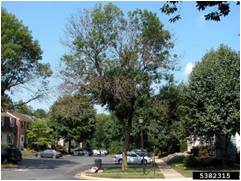 |
|---|
“D” shaped exit holes
“D” shaped exit holes on your tree definitively indicate Emerald Ash Borer. |
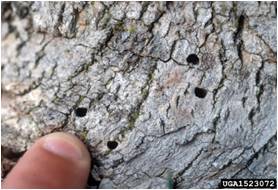 |
|---|
“S” shaped galleries
Underneath the bark, Emerald Ash Borer will make “S” shaped galleries as it tunnels through the tree. |
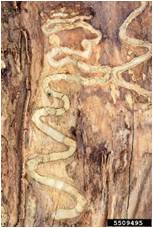 |
|---|
Bark splitting
Vertical cracks in the bark might appear along the trunk or branches |
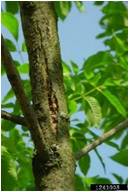 |
Epicormic sprouts
Sprouts may form around the tree base or branches, indicating that your tree is stressed. |
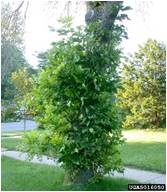 |
Don’t mistake these look-alikes for Emerald Ash Borer
Native Borers
We have several species of native ash borers. The lilac/ash borer (left) and the banded ash borer (right) have larger, rounder exit holes than Emerald Ash Borer.
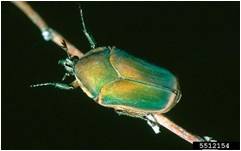
Green June beetle |
Photography Acknowledgements:
- Eggs: David Cappaert. Bugwood.org
- Larvae: David Cappaert, Bugwood.org
- Adult 1: Pennsylvania Department of Conservation and Natural Resources- Forestry, Bugwood.org
- Adult 2: David Cappaert, Bugwood.org
- Woodpecker damage: Kenneth R. Law, USDA APHIS PPQ, Bugwood.org
- Crown thinning: Eric R. Day, Virginia Polytechnic Institute and State University, Bugwood.org
- Exit hole: Daniel Herms, The Ohio State University, Bugwood.org
- Galleries: William M. Ciesla, Forest Health Management International, Bugwood.org
- Bark Splitting: Michigan Department of Agriculture, Bugwood.org
- Sprouts: Pennsylvania Department of Conservation and Natural Resource, Bugwood.org
- Lilac/ash borer: Steven Katovich, USDA Forest Service, Bugwood.org
- Banded ash borer: Whitney Cranshaw, Colorado State University, Bugwood.org
- Bronze birch borer: Whitney Cranshaw, Colorado State University, Bugwood.org
- Sweat bee: David Cappaert, Bugwood.org
- Common green bottle fly: Joseph Berger, Bugwood.org
- Green June beetle: Kansas Department of Agriculture, Bugwood.org
- Japanese beetle: Steven Katovich, USDA Forest Service, Bugwood.org
- Six spotted tiger beetle: David Cappaert, Bugwood.org